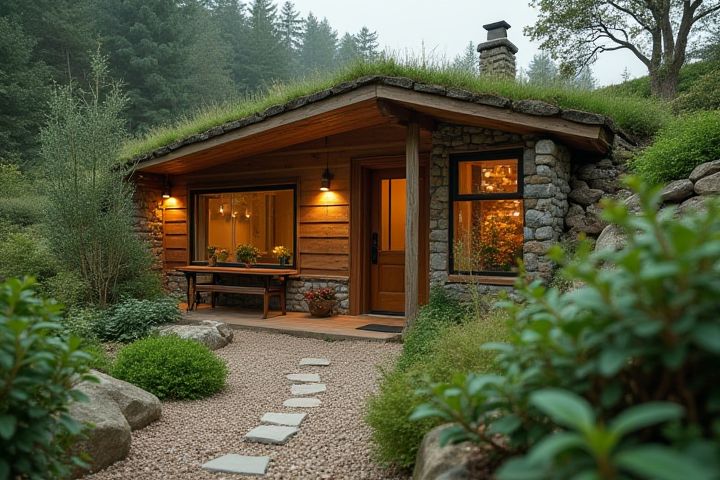
Underground houses, also known as earth-sheltered homes, can significantly save energy due to their natural insulation properties. The earth surrounding these structures helps maintain a stable temperature, reducing the need for heating in winter and cooling in summer. By minimizing exposure to harsh weather conditions, underground homes can lower energy consumption and decrease reliance on artificial climate control systems. Incorporating energy-efficient appliances and renewable energy sources, like solar panels, further enhances their sustainability. You can enjoy a comfortable living environment while contributing to energy conservation and reducing your carbon footprint with an underground house.
Do Underground Houses Save Energy
Natural insulation from soil
Underground houses benefit significantly from natural insulation provided by the surrounding soil, which maintains stable temperatures throughout the year. This insulation reduces the need for artificial heating and cooling, thereby lowering energy consumption and minimizing utility bills. The earth's earth cover acts as a protective buffer against extreme weather conditions, ensuring a comfortable living environment regardless of external temperatures. By harnessing the thermal mass of the soil, you can enjoy a sustainable, energy-efficient home that effectively utilizes natural resources.
Stable indoor temperature
Underground houses maintain a stable indoor temperature by leveraging the earth's natural insulation properties. The soil surrounding these structures provides a consistent thermal mass, usually ranging from 50degF to 70degF, depending on the geographical location. This ambient temperature reduces the need for excessive heating or cooling, leading to potential energy savings of up to 50% compared to traditional above-ground homes. By minimizing energy consumption and regulating climate fluctuations, underground houses present an eco-friendly alternative that can significantly lower utility bills for homeowners.
Reduced heating and cooling costs
Underground houses, often referred to as earth-sheltered homes, significantly reduce heating and cooling costs by utilizing natural insulation provided by the surrounding soil. Earth temperatures remain relatively stable throughout the year, allowing these homes to maintain a more consistent indoor climate, which can minimize energy consumption by up to 50%. The design typically requires fewer heating or cooling systems, translating to lower utility bills while also reducing your carbon footprint. In regions with extreme weather, this technique can enhance energy efficiency further, making underground houses an environmentally conscious choice for homeowners seeking sustainability.
Minimal temperature fluctuations
Underground houses significantly contribute to energy savings due to their naturally regulated temperatures, often maintaining a minimal variation of around 10 to 15 degrees Fahrenheit from the outside environment. This consistent thermal stability reduces the reliance on heating and cooling systems, which can save homeowners an estimated 50% on energy costs annually. The earth's insulating properties shield the home from extreme weather, minimizing the environmental impact while keeping your living space comfortable year-round. With advancements in design and building materials, these homes not only promote eco-friendliness but also enhance energy efficiency through strategic placement and landscaping.
Energy-efficient design
Underground houses, designed with energy efficiency in mind, can significantly reduce heating and cooling costs, often achieving a 50% reduction in energy consumption compared to traditional homes. The earth's natural insulation regulates indoor temperatures, maintaining a steady climate that minimizes reliance on artificial heating and air conditioning systems. Incorporating energy-efficient features such as triple-glazed windows and radiant floor heating can further enhance sustainability. By utilizing natural resources and optimizing design, underground houses can offer both comfort and substantial energy savings throughout the year.
Lower heat loss
Underground houses significantly reduce heat loss due to their natural insulation from the surrounding earth, maintaining a stable interior temperature throughout the year. The earth acts as a thermal mass, absorbing and retaining heat during colder months while providing a cooler environment during summer. This energy-efficient design lowers heating and cooling costs, ultimately benefiting both your wallet and the environment. By minimizing exposure to wind and temperature fluctuations, underground homes offer a sustainable solution for energy conservation.
Protection from extreme weather
Underground houses, or earth-sheltered homes, provide exceptional energy efficiency and protection from extreme weather conditions. By being partially or fully buried, these structures maintain a stable internal temperature, reducing the need for heating and cooling systems. The surrounding earth acts as insulation, shielding occupants from harsh elements such as wind, rain, and extreme temperatures. For those looking to minimize their environmental impact, underground homes offer a sustainable living solution while ensuring comfort and safety during severe weather events.
Reduced carbon footprint
Underground houses significantly reduce energy consumption and contribute to a lower carbon footprint by leveraging natural insulation from the earth. The stable underground temperatures minimize heating and cooling demands, leading to reduced reliance on fossil fuels for climate control. Additionally, these homes often utilize renewable energy sources, further decreasing greenhouse gas emissions. By opting for an underground living space, you can actively participate in sustainable architecture that supports environmental conservation.
Passive solar gain potential
Underground houses leverage passive solar gain to significantly reduce energy consumption, utilizing the Earth's natural insulation to maintain stable indoor temperatures. By burying structures partially or fully, they minimize heat loss in winter and prevent overheating in summer, often achieving projections of 60% or more in energy savings compared to conventional homes. Solar exposure is maximized through strategically placed windows and skylights, allowing sunlight to warm the interior, while thick earth walls regulate temperature fluctuations. This innovative design not only benefits your energy bills but also promotes sustainability by reducing reliance on heating and cooling systems.
Efficient use of natural resources
Underground houses can significantly save energy by leveraging the earth's natural insulation properties, maintaining a stable internal temperature year-round. Built into soil or rock, these structures benefit from an average subterranean temperature of about 50degF (10degC), reducing the need for heating in winter and cooling in summer. This efficient use of natural resources not only decreases energy consumption but also minimizes reliance on fossil fuels, reducing your carbon footprint. Furthermore, the earth's cover protects against weather extremes, further enhancing energy stability and comfort.
